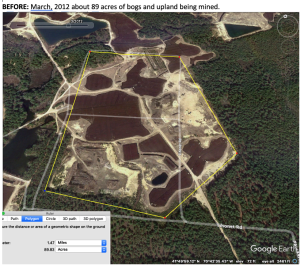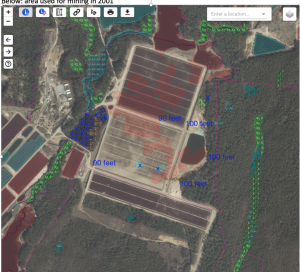-
2 miles of industrial solar proposed near Frogfoot Brook
-
With other proposed solar and sand mining in the area will destroy what’s left of last wildlife and biodiversity corridor between Myles Standish and Buzzards Bay
-
Impacts to globally rare ecosystem: streams and aquatic life
-
Not “green energy” but get rich scheme for Makepeace & solar developer REDP
-
Includes lithium ion battery storage (BESS) in a wetland area
-
Preserve and restore the Frogfoot area – don’t destroy it with industrial solar!
What’s Happening
A.D. Makepeace Cranberry Co. of Wareham MA proposes two miles of solar panel canopies installed over agricultural canals adjacent to its bogs in South Plymouth. Makepeace used to call these the Carverside bogs. It renamed Canning Bogs recently. The bogs are in a globally rare biodiversity hotspot surveyed and inventoried by the Natural Heritage & Endangered Species Program in about 2003. Here is the company’s September 18, 2023 Press Release.
Wetlands Permit Appeal
On January 16, 2024, the Plymouth Conservation Commission granted a wetlands permit for the project. See the permit here. Wetlands Order of Conditions 57-3343 The Commission granted waivers and variances from the Plymouth Wetlands Protective Bylaw. This was wrong. The Planning Board also rubber stamped this project.
On February 20, 2024, Save the Pine Barrens/CLWC appealed the Plymouth Conservation Commission permit to the Mass DEP. The appeal is here. Wetlands Appeal and Exhibits.
The wetlands appeal process requires the DEP to issue a Superseding Order of Conditions. A site visit is scheduled for April 18, 2024 at 10 a.m. It is open to the public.
On December 18th, 2024 MassDEP issued a SOC approving the industrial energy generating facility.
On December 20th, 2024 a Ten Residents Group and Save the Pine Barrens filled an appeal to the SOC.
- The petitioners claim that the Superseding Order of Conditions (SOC) does not adequately acknowledge the potential negative impacts of the project on protected interests, such as wildlife habitat and water supply. They argue that the project’s location makes these impacts likely, and that the SOC should reflect these concerns.
- The petitioners assert that the Notice of Intent (NOI) and the Site Plans fail to provide adequate information about the location of the 10-year floodplain, which could hinder the project’s ability to effectively mitigate flooding risks. They also point out that the plans do not include base flood elevation data for the FEMA 100-year floodplain.
- The petitioners argue that the SOC relies on inaccurate and incomplete delineations of important Resource Areas, such as the Wankinco Riverfront Area, which could compromise the protection of these areas during project implementation. They provide several examples of inaccuracies, including the failure to correctly delineate the 100-foot Buffer Zone.
- The petitioners allege that the SOC does not meet the requirements of the Stormwater Standards, specifically in terms of identifying pollution prevention measures for Battery Energy Storage Systems. They also express concerns that the SOC’s allowance for project segmentation violates the Stormwater Standards.
- The petitioners contend that the SOC does not adequately consider MassDEP Program Policy 17-1, especially regarding its emphasis on protecting public and private water supply, groundwater resources, wildlife habitat, and flood control. They argue that the SOC should be revised to better align with the principles outlined in Program Policy 17-1 to ensure comprehensive environmental protection.
MEPA Environmental Study Now Required
The state is requiring Makepeace to include the Damage to the Environment caused by the Canning Solar project to be included in its MEPA review for the adjacent 54 acre solar project. This other proposed project is located at 0 Tihonet Road in Wareham and is called North Wareham Solar. In March, 2024, the state Secretary of Energy and Environmental Affairs issued a MEPA certificate on the environmental study for the North Wareham Solar project. It requires the Canning Solar project in Plymouth to be studied for the cumulative Damage to the Environment. Read more here.
The new Canning solar and North Wareham solar projects are in addition to three proposed in Wareham, one already built nearby and others in Carver. In total Makepeace has destroyed hundreds of acres of forests for at least 15 large ground mounted solar projects. This includes clearing forests to create “farmland” for dual use solar at Swan Holt bogs in Carver. These areas are surrounded by Makepeace’s proposed and ongoing sand mining operations.
About the Site: History of Waste Dumping and Mining
The Canning bogs where the canal solar is proposed was historically traditional cranberry bogs, probably created in the mid 1900s. This involved draining, diking and diverting wetlands and streams. Starting in 2010, Makepeace started to mine the upland around the old Carverside bogs for sand and gravel. This included mining in the aquifer. Makepeace claimed the mining was necessary to “square off” the old style irregular shaped bogs to make them rectangular and efficient. After mining, Makepeace filled in the hole created by the mining with debris that appears to be stumps and tree logs. Eyewitnesses say Makepeace also dumped sewage sludge in the pits. Today cranberry bogs cover the pits. A Google Earth Pro chronology is below.


There is no known earth removal or permit for Makepeace’s mining at the Carverside bogs. Burying wood and operating a dump here harms the environment. In 2022, CLWC reported this to the Town of Plymouth Board of Health. There has been no response. See the report here.
CLWC has also asked the MassDEP Environmental Strike Force to investigate. Here: Request for Environmental Investigation
Who is “Renewable Energy Development Partners” and What Have They Done?
REDP consists of former Makepeace real estate executives Hank Ouimet and Tom Melehan. The two plied their knowledge of local real estate obtained while working for Makepeace to get land for large development projects such as industrial solar. Once they get the local solar permits, REDP sells them to Wall Street investors. Makepeace and REDP are both responsible for disastrous and some say fraudulent solar projects throughout Southeastern Massachusetts.
These projects include:
- In Wareham, Makepeace, REDP and Beals+Thomas are responsible for strip mining a biodiversity hotspot and Priority Habitat on Charlotte Furnace Road. The project is now a 50-acre solar site.
- In Carver at the Swan Holt bog site, REDP and Makepeace started installing copper chromated arsenic wood poles in wetlands to mount solar panels. They only stopped when there was public outrage. They replaced the poles with metal. Now there is about 1 mile of solar on a stream. With Beals + Thomas the companies clear cut and strip mined about 12 acres of forest to create “farmland” to get state SMART solar subsidies for “dual use” agricultural solar. The SMART program incentivized this strip mining and deforestation.
- In Plymouth in 2016, REDP obliterated about 25 acres of pristine forest in the Herring River ACEC and on a known Wampanoag area for large solar. Then REDP flipped the project to a “renewable energy” venture capital fund.
- In Carver on Gate Street REDP installed solar shortly after the area was strip mined. In about 2021, Hank Ouimet admitted in a public hearing that even though this was “agricultural solar” the company had no “agriculture” under the panels as required by the SMART solar regulations.
- In Rochester, REDP installed a dual use solar project on a bog and admitted it had no farm plan yet sought SMART solar subsidies.
